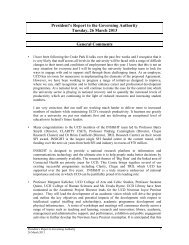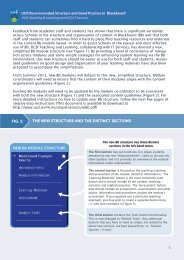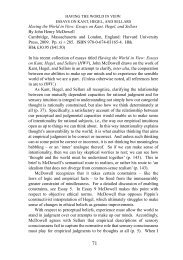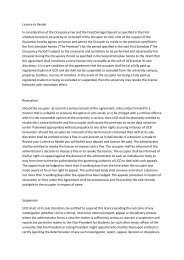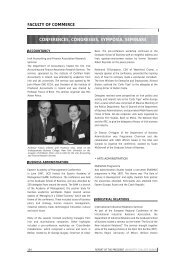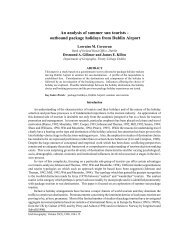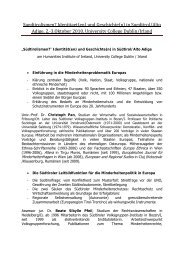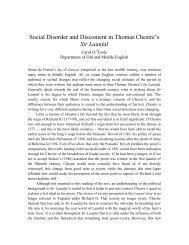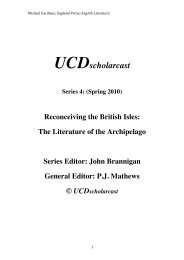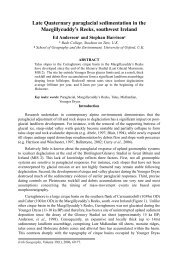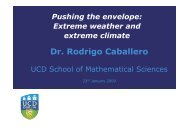Featured in this issue: - University College Dublin
Featured in this issue: - University College Dublin
Featured in this issue: - University College Dublin
Create successful ePaper yourself
Turn your PDF publications into a flip-book with our unique Google optimized e-Paper software.
The American Civiliz<strong>in</strong>g Process<br />
Professor Stephen Mennell<br />
By draw<strong>in</strong>g comparisons between the USA<br />
and other countries throughout the world, <strong>in</strong><br />
his latest book ‘The American Civiliz<strong>in</strong>g<br />
Process', Professor Stephen Mennell (UCD<br />
School of Sociology) discusses American<br />
manners and lifestyles, violence <strong>in</strong> American<br />
society, the impact of markets on American<br />
social character, American global expansion,<br />
the 'curse of the American Dream’ and<br />
<strong>in</strong>creas<strong>in</strong>g <strong>in</strong>equality, and the religiosity<br />
of American life.<br />
Viewed from Europe, Professor Mennell shows<br />
America as a land of familiar paradoxes. “An<br />
agreeable civility habitually prevails <strong>in</strong> most<br />
everyday relations among people <strong>in</strong> America -<br />
yet the US is almost the last bastion among<br />
advanced democratic nations of capital<br />
punishment,” he says.<br />
“In most parts of America, the laws and social<br />
customs strongly restra<strong>in</strong> people from do<strong>in</strong>g<br />
harm to themselves and others by smok<strong>in</strong>g -<br />
yet the laws and social customs only weakly<br />
restra<strong>in</strong> people from do<strong>in</strong>g harm to themselves<br />
and others by the use of guns, and the murder<br />
rate is about four times as high per capita as <strong>in</strong><br />
Western Europe,” he expla<strong>in</strong>s.<br />
In ‘The American Civiliz<strong>in</strong>g Process’ Professor<br />
Mennell asks can history and social science help<br />
to expla<strong>in</strong> these seem<strong>in</strong>g paradoxes and to<br />
show how they relate to each other. He also<br />
exam<strong>in</strong>es how Americans see themselves, how<br />
they view the rest of the world, and how the<br />
rest of the world sees them - <strong>in</strong> the light of<br />
America as an ever-expand<strong>in</strong>g global power.<br />
Those concerned about America’s role <strong>in</strong> the<br />
world today would be well served by read<strong>in</strong>g<br />
<strong>this</strong> compell<strong>in</strong>g and provocative work, which<br />
uses Norbert Elias’s theory of civiliz<strong>in</strong>g<br />
processes to trace how America reached its<br />
present position <strong>in</strong> the world.<br />
Computational Fluid<br />
Dynamics <strong>in</strong> Food Process<strong>in</strong>g<br />
Computer Vision Technology<br />
for Food Quality Evaluation<br />
Edited by Professor Da-Wen Sun<br />
Two new books by Professor Da-Wen Sun<br />
(UCD School of Agricultural, Food Science<br />
and Veter<strong>in</strong>ary Medic<strong>in</strong>e) entitled<br />
‘Computational Fluid Dynamics <strong>in</strong> Food<br />
Process<strong>in</strong>g' and ‘Computer Vision Technology<br />
for Food Quality Evaluation’ have recently<br />
been published by CRC Press / Taylor &<br />
Francis and Academic Press / Elsevier,<br />
respectively. Both computer vision and<br />
computational fluid dynamics (CFD) are<br />
novel techniques for the food <strong>in</strong>dustry, and<br />
these two new titles are the first <strong>in</strong> these<br />
rapidly expand<strong>in</strong>g areas.<br />
“These two unique works provide eng<strong>in</strong>eers and<br />
technologists work<strong>in</strong>g <strong>in</strong> research, development,<br />
and operations <strong>in</strong> the food <strong>in</strong>dustry with<br />
critical, comprehensive and readily accessible<br />
<strong>in</strong>formation on the art and science of the<br />
techniques, and their publication is much<br />
demanded and has met the market needs”, said<br />
Professor Sun, the editor of the books.<br />
CFD is a state-of-the-art simulation tool for<br />
solv<strong>in</strong>g fluid flow problems. It allows eng<strong>in</strong>eers<br />
to computer-test concepts all the way through<br />
the development of a process or system.<br />
Contributed by 55 <strong>in</strong>ternational peers with both<br />
academic and professional credentials, and<br />
consist<strong>in</strong>g of 28 chapters, 'Computational Fluid<br />
Dynamics <strong>in</strong> Food Process<strong>in</strong>g' presents an<br />
overview of <strong>this</strong> powerful design and analysis<br />
tool and offers an <strong>in</strong>-depth discussion of recent<br />
advances and applications <strong>in</strong> the food <strong>in</strong>dustry.<br />
Computer vision is a novel technology for<br />
recognis<strong>in</strong>g objects and extract<strong>in</strong>g quantitative<br />
<strong>in</strong>formation from digital images <strong>in</strong> order to<br />
provide objective, rapid, non-contact and<br />
non-destructive quality evaluation. Especially <strong>in</strong><br />
recent years, significant scientific and<br />
technological advances have been made <strong>in</strong><br />
quality <strong>in</strong>spection, classification and evaluation<br />
of a wide range of food and agricultural<br />
products. ‘Computer Vision Technology for Food<br />
Quality Evaluation’ therefore focuses on these<br />
recent advances.<br />
Professor Sun is an <strong>in</strong>ternationally recognized<br />
figure for his leadership <strong>in</strong> food eng<strong>in</strong>eer<strong>in</strong>g<br />
research and education. He is among the first to<br />
<strong>in</strong>troduce CFD and computer vision technology<br />
for food applications to UCD and Ireland <strong>in</strong><br />
1997, and has made significant lead<strong>in</strong>g<br />
contributions <strong>in</strong> these areas over the years,<br />
which has earned UCD an <strong>in</strong>ternational<br />
reputation <strong>in</strong> research <strong>in</strong> the fields.<br />
Hidden Streams - A New History<br />
of Dun Laoghaire-Rathdown<br />
In Hidden Streams, local historian Brian Mac<br />
Aongusa takes the reader on a voyage of<br />
discovery of the past <strong>in</strong> the area of South<br />
County Dubl<strong>in</strong> that is now known as Dun<br />
Laoghaire-Rathdown.<br />
Follow<strong>in</strong>g his retirement, Brian undertook a<br />
modular BA degree at UCD, focus<strong>in</strong>g on History<br />
and Historical Geography. His thesis subject<br />
‘Water Courses and Settlements <strong>in</strong> the Dubl<strong>in</strong><br />
Half Barony of Rathdown’ excited his <strong>in</strong>terest <strong>in</strong><br />
the <strong>in</strong>fluence of rivers and streams <strong>in</strong> the area.<br />
By trac<strong>in</strong>g their significance <strong>in</strong> the lives of the<br />
first prehistoric visitors and <strong>in</strong>habitants, the<br />
early Christians, the Vik<strong>in</strong>gs and the Anglo-<br />
Normans, the book throws a new light on many<br />
of the monuments and landscape features that<br />
are still visible today. A study of early maps<br />
from 1685 reveals a fasc<strong>in</strong>at<strong>in</strong>g world of waterpowered<br />
<strong>in</strong>dustries, side by side with the<br />
15<br />
growth of the first suburbs of K<strong>in</strong>gstown,<br />
Blackrock, Kill<strong>in</strong>ey and Ballybrack, and Dalkey.<br />
In the twentieth century the unrelent<strong>in</strong>g<br />
growth of Dubl<strong>in</strong>’s southern suburbs has<br />
severely impacted on the landscape, caus<strong>in</strong>g<br />
many of its small rivers and streams to be<br />
smothered by developments that have driven<br />
them underground, out of sight or even out<br />
of memory.<br />
Remember<strong>in</strong>g<br />
the War Dead<br />
by FergusD’Arcy<br />
From the 1920s the Office of Public Works<br />
has been responsible for the graves of those<br />
who died <strong>in</strong> the two World Wars and are<br />
buried and commemorated <strong>in</strong> the Republic of<br />
Ireland. There are at least 3,100 such war<br />
graves <strong>in</strong> the Republic of Ireland and some<br />
2,600 <strong>in</strong> Northern Ireland.<br />
The history of the 3,000 plus war dead buried <strong>in</strong><br />
the Republic of Ireland, how they came to be<br />
there, and how the Irish Government came to<br />
be responsible for the graves is outl<strong>in</strong>ed <strong>in</strong> a<br />
new book, Remember<strong>in</strong>g the War Dead, by<br />
Fergus D’Arcy, former Dean of Arts at <strong>University</strong><br />
<strong>College</strong> Dubl<strong>in</strong>, published by the Office of<br />
Public Works.<br />
“Many people are familiar with the OPW as the<br />
manager of the State’s property portfolio, its<br />
wide range of construction and eng<strong>in</strong>eer<strong>in</strong>g<br />
projects, and its management of the State’s<br />
heritage, along with the myriad of other<br />
functions that affect many aspects of the lives<br />
of the citizens and people of <strong>this</strong> country,” said<br />
Noel Ahern TD, M<strong>in</strong>ister of State at the<br />
Department of F<strong>in</strong>ance, with special<br />
responsibility for the Office of Public Works,<br />
who officially launched the book.<br />
“However, there are some functions that are<br />
little known to the general public and one of<br />
these is the Office’s responsibilities <strong>in</strong> the<br />
ma<strong>in</strong>tenance of the ‘Commonwealth War Grave<br />
sites' of those who died as a result of the two<br />
great wars of the last century,” he expla<strong>in</strong>ed.<br />
“This book is unique <strong>in</strong> that it reflects the<br />
<strong>in</strong>ternational nature of these graves that mark<br />
the rest<strong>in</strong>g places of people from over twenty<br />
different nations. The majority of these are Irish<br />
and Britons but it is important to also<br />
remember the other Europeans, North<br />
Americans, Australians, New Zealanders and<br />
Asians whose war graves also lie here,”<br />
cont<strong>in</strong>ued the M<strong>in</strong>ister.<br />
Professor Fergus D’Arcy has lectured <strong>in</strong> modern<br />
history s<strong>in</strong>ce 1970 and has published <strong>in</strong> the<br />
area of British and Irish political and social<br />
studies. His research <strong>in</strong>terests lie <strong>in</strong> the areas<br />
of social history and popular culture.



